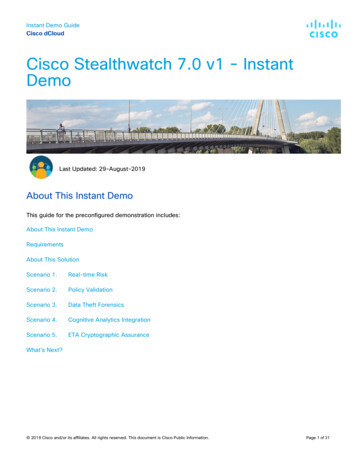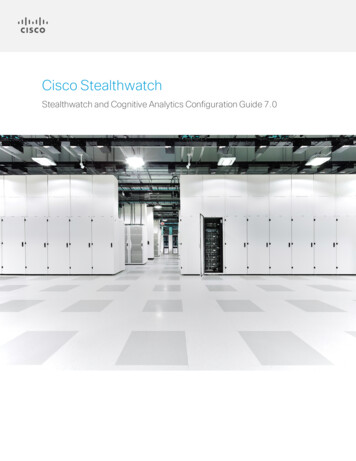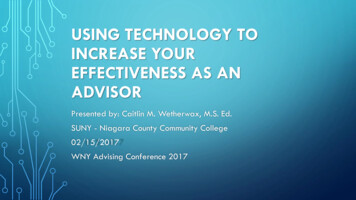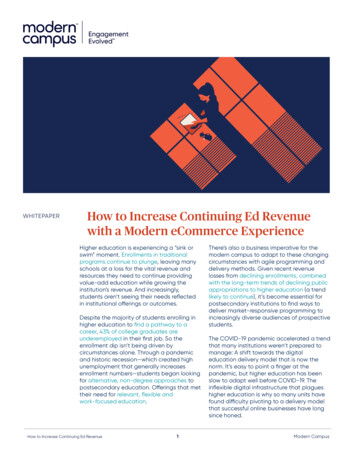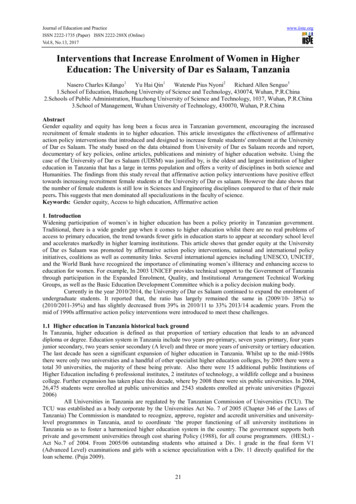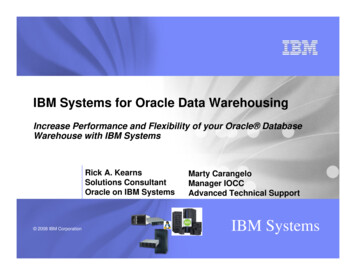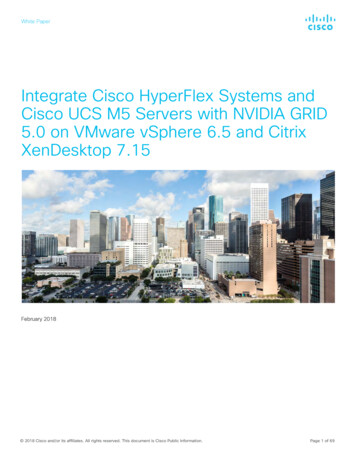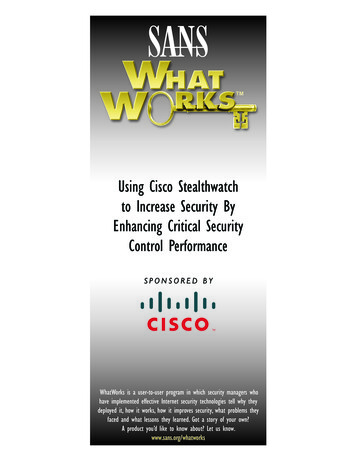
Transcription
Using Cisco Stealthwatchto Increase Security ByEnhancing Critical SecurityControl PerformanceSPONSORED BYWhatWorks is a user-to-user program in which security managers whohave implemented effective Internet security technologies tell why theydeployed it, how it works, how it improves security, what problems theyfaced and what lessons they learned. Got a story of your own?A product you’d like to know about? Let us know.www.sans.org/whatworks
ABOUT ERIE INSURANCEFor more than 90 years, Erie Insurance has been fulfilling its promise to customers to provide auto,home, business and life insurance rooted in the principles of honesty, decency, service, and of course,affordability. Erie Insurance offers products that protect without surprises. Erie’s vast network ofindependent insurance agents serves more than 4 million insurance customers in 12 states and theDistrict of Columbia. With its agents, Erie Insurance continues to carry out the company’s foundingpurpose, “To provide our policyholders with as near perfect protection, as near perfect service asis humanly possible and to do so at the lowest possible cost.”ABOUT THE USERJamison Budacki, a Senior Information Security Architect, joined Erie Insurance in 2011. Jamison¹sfocus at Erie Insurance is on developing usable security architectures as well as developingmonitoring and detection solutions that can be used across the corporate network. Jamison worksdaily with business partners to ensure that secure solutions are developed with a people, process,and technology philosophy. Prior to Erie Insurance, Jamison worked as a Security Engineer for aFortune 100 company on the Incident Response team. Jamison received his Bachelor of Science inInformatics from the School of Informatics and Computing at Indiana University in 2005. Jamisonhas maintained a CISSP certification since 2007. He resides in Erie, Pennsylvania, with his wife andtheir two sons.ABOUT THE INTERVIEWERJohn Pescatore, SANS Director of Emerging Security TrendsMr. Pescatore joined SANS in January 2013 with 35 years’ experience in computer, network andinformation security. He was Gartner’s lead security analyst for 13 years, working with global 5000corporations and major technology and service providers. Prior to joining Gartner Inc. in 1999,Mr. Pescatore was Senior Consultant for Entrust Technologies and Trusted Information Systems,where he started, grew and managed security consulting groups focusing on firewalls, networksecurity, encryption and Public Key Infrastructures. Prior to that, Mr. Pescatore spent 11 years withGTE developing secure computing and telecommunications systems. Mr. Pescatore began his careerat the National Security Agency, where he designed secure voice systems, and the United StatesSecret Service, where he developed secure communications and surveillance systems. He holdsa Bachelor’s degree in Electrical Engineering from the University of Connecticut and is an NSACertified Cryptologic Engineer. He is an Extra class amateur radio operator, callsign K3TN.SUMMARYAudits, penetration tests, and self-assessments had convinced the Senior Information SecurityArchitect at Erie Insurance that Erie needed to improve situational awareness to speed updetection, response and resolution of cyber-threats. Erie focused on tools that could be shared bythe security group and the network operations group, to increase collaboration and coordination ofefforts. After evaluating several products, Erie chose Cisco Stealthwatch and was able to documentimprovement in security metrics, including more effective coverage and implementation of the CISCritical Security Controls.SANS WhatWorksErie Insurance Uses Cisco Stealthwatch to Increase Security By Enhancing Critical Security Control Performance
Q Give us an idea of your background and your role at ErieInsurance.A My name is Jamison Budacki, and I’m a Senior InformationSecurity Architect at Erie Insurance. I’ve been there forabout five years. My role consists of setting the direction forInformation Security for the company and ensuring that thebusiness’s future direction is done with security in mind. Beforethat, I was an Information Security Engineer at a Fortune100 company where I worked for five years on the incidentresponse team.Q In your role as InfoSec architect, do you report to theCISO?A I am currently on the Enterprise Architecture team. I workclosely with the Information Security department on a dailybasis. Enterprise Architecture and Information Security bothreport to the CISO.Q What sort of problems were you having or what reasonsdid you have for looking around for solutions likeStealthwatch?A We needed improved situational awareness on our networkas a whole, especially insight into our remote branch locations.Our prior toolset led to a number of challenges, some ofwhich were:ChallengesMultiple ToolsToo much informationManual correlationPoor proactive alerts and alarmsLimited RetentionNo compatibility with other technologyNo user attributionTargeted OpportunitiesReduce the time to find the informationImprove efficiency and time usageImprove remediation timeImprove mean time to know (MTTK)Increase historical data retentionIncrease value with compatibilityGain user and device informationQ Since you were down the path of looking for solutions,you probably knew you were going to end up havingto spend some money. How did you get the budget todo this or how did you convince management? Was ita specific initiative or was it just part of architectureimprovements? How did you justify the budget to do this?A We had numerous penetration tests that had similar themesand underscored our need to improve in areas such asnetwork segmentation and monitoring and detectioncapabilities. As part of our strategy for addressing those issues,we adopted the CIS Critical Security Controls (version 5.1).We conducted a self-assessment against the 20 controls withthe goal of getting an understanding of how we scored ineach of the controls. When it came time to purchase a newtechnology or perform an initiative within information security,we would take the idea and evaluate it against the CIS CriticalSecurity Controls. We then asked ourselves, “Does this moveour self-assessment scores if we were to do this?” The analysisand capabilities that Stealthwatch offers had a significant impacton our self-assessment scores. To give some context to our approach, the scorecardbelow illustrates self-assessment scores before and after theStealthwatch implementation for a fictitious company. Forexample, the blue bar and the percentage to the right of eachcontrol represent the scores of Acme, Inc. before implementingStealthwatch. The gold triangle shows the self-assessmentscore after implementation.Q There are often tools the security side may buy anduse, and then there are often tools in use by networkoperations. Is there a consolidated view acrossnetwork operations on the security side? Are they doneindependently? How does that work?A In the past they were absolutely done independently.Overthe past couple of years, we started to work closely withthe network team. Through our collaboration, we started toget insight into things like using NetFlow with Stealthwatch,and deploying Cisco ISE and integrating it into our existingprocesses and technology. The recent collaboration has reallybenefited both teams, allowing us to share technologies andideas that make each team better. CSC 5: Malware Defenses improved by 21%. CSC 13: Boundary Defense improved by 27%. CSC 14: Maintenance, Monitoring, and Analysis of Audit Logsimproved by 13%. CSC 18: Incident Response and Management increased by 7%. CSC 19: Secure Network Engineering increased by 15%.SANS WhatWorksErie Insurance Uses Cisco Stealthwatch to Increase Security By Enhancing Critical Security Control Performance
A few years later, we also conducted the same process for theNIST Cybersecurity Framework. Like the previous scorecardfor the CSCs, the scorecard below was designed to portrayour self-assessment against the NIST Cybersecurity Framework.Once again, the blue bar illustrates the level of maturity beforeimplementing Stealthwatch and the gold triangle shows thelevel of maturity after implementation. Stealthwatch had a highimpact on the Detect function, a medium impact on the Respondfunction, and a low impact on both the Identify and Protectfunctions, respectively. Lastly, two sections were added to thescorecard; the first is titled “major milestones” and the other“targeted objective.” The major milestones section is the chanceto highlight what went well in the self-assessment period. Thetargeted-objectives section is the time to show what will be donefor the next assessment period. The key for these is to speak inbusiness terms as this scorecard canbe shared with the board of directorsto answer the question “How is myinformation security team doing?”had some interesting use-cases at the time. One of the usecases was utilizing Gigamon to create the flows. This was a newfunction for Gigamon and we wanted to make sure we weregetting the output we expected. The second use-case wastesting new firewall code that would enable the NAT stitchingthat we needed.Q What were your top two or three criteria?A The biggest one for us was the scalability and compatibility withother tools. As I mentioned earlier, we have quite a few toolsthat we like to integrate with, such as our SIEM, Gigamon, IPAddress Management, Cisco ISE, and Cisco ASA firewalls. Wealso have secondary firewall vendors and wireless intrusiondetection sensors.O ne of the use-cases was thatwe really needed to addressNAT stitching and the ability topull some user attribution out ofthe firewall logs that we alreadyhad. Another major compatibilityuse-case we had was to utilize ourexisting Gigamon infrastructure.We use Gigamon for its SPANsession capabilities, deduplication,and creation of the NetFlowrecords. So, for us, our Gigamoninfrastructure is the starting pointfor all of our NetFlow minus a fewof the firewalls.Aside from greatly improving ourself-assessment scores, Stealthwatchhas reduced our mean time toknow (MTTK) and our mean timeto respond (MTTR). Stealthwatchhas also been integrated withother investigation tools for greateroperational insight into incidents andvisibility into all areas of our network.Q So, you had a good startingpoint. Walk us through theprocess you used to evaluateand to find a good solution.QA Basically, we created a list of criteriathat were important to us. Then,we took a look at some of thevendors in the space and attendedthe vendor webinars to get an ideaof each vendor’s capabilities. From there, we narrowed it downand had some further discussions with a few select vendors.Lastly, we conducted a POC in our lab environment. Another benefit was having experience with NetFlowtechnologies at my previous employer.Q ow many different companies did you compare whenHyou got to the proof of concept bakeoff?A e started with two commercial products, Cisco and Plixer,Wand a few open-source programs. We quickly eliminated a fewdue to the lack of some of our requirements. We then fullytested the Cisco Stealthwatch solution in the lab, because weSANS WhatWorksA So, to get an idea architecturally, you had Gigamon feedingNetFlow data to Stealthwatch,you used a top-level SIEM side/reporting side, and you hadIP address management data.Where were things like theuser attribution? Where is thatall getting tied together? For us, another requirement was the user attribution, and wewere heading down the path of deploying Cisco ISE. Thishelped us fortify that decision, because we’ve integratedCisco ISE with the Stealthwatch solution to provide that userattribution. This integration gives us the ability to easily searchfor a user within Stealthwatch. In the future, we’re looking toautomate some remediation decisions based on Stealthwatchrules. As an example, a client is going to a known bad site orexfiltrating a known high amount of data. We can send theclient to a remediation VLAN where they will have less accessto the network, get remediated, and then be returned to theproduction environment.Erie Insurance Uses Cisco Stealthwatch to Increase Security By Enhancing Critical Security Control Performance
The integration of ISE and Stealthwatch has been extremelyhelpful in user attribution as well as deeper insight intothe devices on the network. We are now able to getthe username within the flows that we are reviewing.Device visibility has also improved with the addition of theMAC address, device operating system, as well as devicemanufacturer. These additions of the username and deviceinfo are directly from ISE integration.Q Walk us through the timeline between the point whereyou made the decision to use Stealthwatch and whereyou are today. How did you go about deploying and howlong did it take?AQ You mentioned scalability was one of your top criteria.What is the scale and scope of what you’re planning forfrom a deployment point of view; i.e., number of nodeson the network or users or locations.A Erie Insurance has about 5,000 employees. We haveapproximately 18,000 independent agents and supportstaff. The agents aren’t on our network, but they do interactwith our systems. Our goal was to get as much coverageas possible within our network. We’re doing about 20,000flows per second that consist of all the traffic on the network,workstations to DMZ/Datacenter, DMZ/Datacenter toworkstation, workstations to external, and DMZ/Datacenterto external. Right now, we’re evaluating workstation-toworkstation traffic.Q To understand, Stealthwatch has three components; themanagement console, flow sensors, and flow collectors?Are the physical appliances on the collector side andy ou’re able to run theconsole as a virtualsoftware? How did thatwork?Q Wherever youhad Gigamoncapability, you’re nowforwarding that datato Stealthwatch? Ordid you say, “Now,that we’re usingStealthwatch, we alsohave to add otherspan ports” or moremonitoring capabilitiesin addition to what youoriginally had?AA We’re basically usingGigamon for the creationof SPAN sessions, the deduplication of traffic, then the creationof NetFlow. The NetFlow records are then forwarded tothe Stealthwatch collector. We’re also getting NetFlow fromour firewalls (internal and external). This adds more userattribution for us, and it’s making use of some NAT stitchingcapabilities from both firewall vendors. NAT stitching reducesthe amount of flows we see. Stitching takes the public InternetIP address and our internal IP address and combines it into asingle flow record. This enables us to see the actual host inquestion and not just a NAT address.SANS WhatWorks Like everything, the longest part is getting all the contractsand agreements in place. Once everything was in place, wedeployed it pretty quickly. We did quite a bit of upfront testingwith our existing technology and the Stealthwatch solution.Stealthwatch analyzed flows from Gigamon to ensure that wewere getting what we wanted out of it into its lab environment,as well in our lab environment. A lot of the experts therewent through and validated everything was working correctly,because at the time we were one of the first people to utilizethe NetFlow creation from Gigamon. After we had all thet’s crossed and the i’s dotted, we were able to install it withina week. It was fairly straightforward: send the flows to thecollector, set up all of the hardware as well as some of thevirtual images. e’re actually running theWStealthwatch ManagementConsole as a virtualmachine. We are runningthe flow collector and theflow sensor as physicalhardware. We currentlymonitor our datacenter,various DMZs, campus,and all 25 branch locations.Stealthwatch has providedus insight into areas of ournetwork that we did notpreviously have.Q ho actually views the console and then does anything?WIs that you as an architect? Is that operational? Is itmultiple people?A It’s multiple people. The network team makes use ofStealthwatch as a replacement for a legacy tool that was nolonger being utilized. They also use Stealthwatch for capacityplanning, QoS policy development, and looking for top talkersduring congestion.Erie Insurance Uses Cisco Stealthwatch to Increase Security By Enhancing Critical Security Control Performance
Stealthwatch is primarily used by the InfoSec team and is oneof the main tools when doing any type of investigation (DDoS,infection, data exfiltration, policy violation). In order for InfoSecto be successful, we have learned to ask ourselves four mainquestions when approaching a new process or technology:1) What are our threats?2) What do we want to monitor?3) What can this do for Erie Insurance?4) How does InfoSec respond?Q Based on where you are today and what you wentthrough; knowing what you now know, is there anythingyou would have done differently or any lessons learnedyou want to pass along to other people who mightfollow you on this path?A What are our threats? We understand our threats many ways. Some of the methodswe are using consist of risk assessment and threat intelligence.We utilize various forms of threat intelligence. We subscribeto the Stealthwatch Labs Intelligence Center (SLIC) threat feed,are members of various information sharing groups, createintelligence from previous incidents, as well as utilize OSINT. What do we want to monitor? We make our monitoring decisions based off what thebusiness deems to be important. For that we utilize internalBusiness Impact Analysis reports. We also monitor off existingpolicies, risky assets, anything with an Internet presence, andcompliance/regulations.Q On the “know-your-network side,” you were trying todo user attribution, but, a lot of times along the pathto trying to identify particular PCs and then particularusers, people often run into, “We have problems in theway PCs are named or directories are structured” orother things. Did you have to work through those kindsof problems?What can this do for Erie Insurance? This is where we measure ourselves; in this case we do selfassessments against both the CIS Critical Security Controls andthe NIST Cybersecurity Framework.How does InfoSec respond? Our process consists of playbooks, which are outlines on howto handle an incident. We have playbooks for when we seeknown alerts as well as preemptive playbooks that we useto find bad things on the network. The playbooks are alwaysevolving which helps us with measurement and drives futurecorrelations. The playbooks help us bring some science to theart form of incident response.A A little bit.Our usernames aren’t very humanly recognizable.It’s not very easy for an analyst to look at a username and say,“Oh, that’s Jamison.” So, what we do is send the alert withour username to the SIEM, and that alert will populate withthe actual person’s name. This is done via LDAP queries tothe user store that is needed. We do a couple of those thingsbehind the scenes. Computer names are pretty easy for us,too. Cisco ISE will pull out the computer name, MAC address,and device manufacturer and place that information into theNetFlow records.Q As it relates to alerting or reacting to alerts, is theprocess that somebody’s using the Stealthwatch consoleand starts going through alerts and investigating? Or arethe alerts forwarded to the SIEM and you work throughthose alerts?A It’s a little bit of both. Some alerts we just go directly fromStealthwatch and we get them via email. All of the alarms thatare triggered, we do send to the SIEM, so we can add that toany correlation searches that we may have in the future. Wecan look at those alerts in conjunction with other data likeendpoint vulnerabilities or endpoint alerts. These alerts arealso helpful with other investigations that may not source fromStealthwatch directly.SANS WhatWorks For lessons learned, I would definitely say to find a solutionthat provides enterprise reuse. It’s goin
and creation of the NetFlow records. So, for us, our Gigamon infrastructure is the starting point for all of our NetFlow minus a few of the firewalls. Q So, to get an idea architectur-ally, you had Gigamon feeding NetFlow data to Stealthwatch, you used a top-level SIEM side
